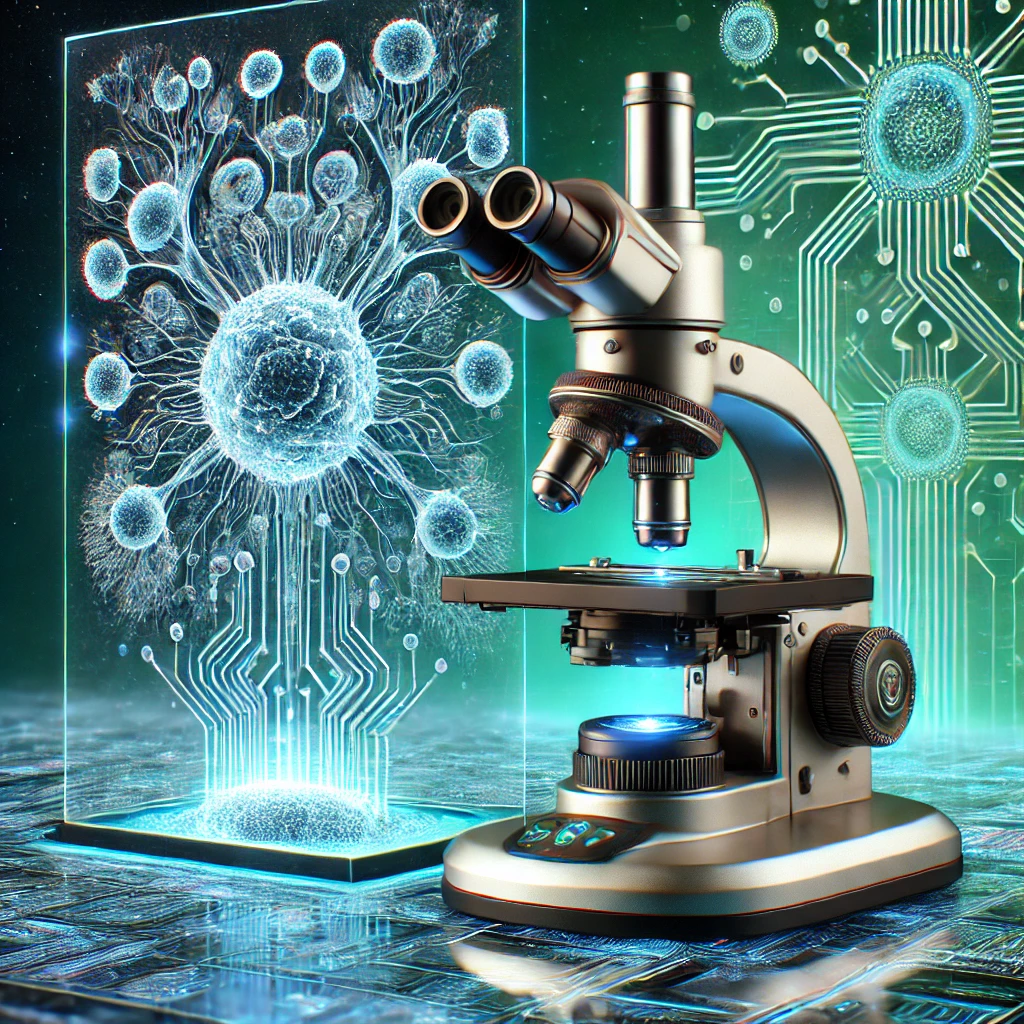Artificial Intelligence, or AI, is the buzzword of 2024 in nearly every industry—and microscopy is no different. The integration of Artificial Intelligence (AI) into microscopy has further advanced life science diagnostics. By harnessing the power of machine learning and deep learning algorithms, AI-driven microscopy has further improved how we visualize and interpret biological samples. But one popular question remains: does the rise of AI mean the end of precision imaging sub-systems in microscopy?
Let’s take a deeper dive.

The Role of Precision Imaging Systems in Life Science Diagnostics
For almost four centuries, precision imaging systems have been the backbone of microscopy. Microscopy sub-systems for life sciences, especially diagnostic applications, have made significant advancements in the last few decades. These sub-systems, including advanced optics, high-resolution objectives, and lighting solutions, have enabled researchers and clinicians to capture the smallest details in biological samples. When dealing with complex structures like cells, tissues, and microorganisms, accurate image quality is paramount for identifying diseases and providing valuable insights into biological processes.
Precision in imaging relies on the hardware itself—high numerical aperture objectives, low aberration lenses, and cutting-edge imaging sensors—to ensure that even the most intricate details are rendered clearly. In life science diagnostics, this capability enables the detection of biomarkers, cell structures, or pathogen morphology that can drive early diagnosis and treatment decisions.
The “AI Revolution” in Microscopy
AI has introduced a new dimension to microscopy by enabling automated image analysis, pattern recognition, and predictive modeling. With deep learning, AI systems can be trained to recognize specific features in microscopic images—such as abnormal cell growth, the presence of bacteria or viruses, or specific biomarkers for diseases like cancer. In many ways, AI can dramatically reduce the time required to interpret complex imaging data while also improving the consistency and accuracy of diagnoses.
AI-driven microscopes have made strides in their ability to compensate for some limitations traditionally addressed by precision optics. For instance, AI algorithms can, to some extent, enhance resolution or even correct some aberrations in real time. This allows the AI imaging system to adapt and improve imaging conditions.
However, the main areas in which AI-driven microscopes are making impacts are in workflow efficiencies, which I’ll discuss in another section. However, this raises the question: what precision imaging sub-systems can AI improve or replace?
AI Is a Complementary Tool, Not a Replacement
While AI can augment microscopy and deliver unprecedented automation and image interpretation capabilities, the precision of imaging sub-systems remains crucial. The reality is that AI’s potential relies on the quality of the data it processes, hence the phrase, ‘garbage in garbage out.’ AI algorithms are still highly dependent on the input provided by the imaging system. A blurred or distorted image, regardless of AI processing, may not deliver the necessary sample information for diagnosis, especially when fine details are critical.
High-quality optics and advanced imaging techniques, as shown in the below diagram (Figure 1), such as confocal microscopy or fluorescence imaging, still play a vital role in providing the foundational data. AI algorithms need accurate data to make accurate predictions. When it comes to precision in diagnostics, especially for early-stage diseases or rare cell anomalies, the combination of AI and precision imaging will likely offer the best results.

AI’s Impact on Workflow Efficiency
AI truly shines when it transforms workflow efficiency and reduces the burden on human operators. Traditional microscopy frequently requires highly skilled technicians to spend time capturing and interpreting images, with potential variability in interpretation. AI and related technologies, on the other hand, can automate the entire process—capturing images, highlighting areas of interest, and even providing preliminary diagnoses. This allows medical professionals to focus on critical decision-making rather than on repetitive tasks, thus accelerating the diagnostic process and improving throughput.
In addition, AI can aid in imaging beyond what human eyes can see, identifying subtle patterns invisible to human observers. For instance, in fluorescence microscopy, AI can be used to denoise images, allowing for clearer interpretation even when photon counts are low.
The Real-World
I always err on the side of caution when utilizing software-based systems. As mentioned earlier, garbage in, garbage out. Companies employing AI-based platforms for diagnostics still require review, input, and supervision by medical experts to ensure the data is accurate during the platform’s development stages.
Artificial intelligence (AI) and machine learning (ML) technologies have the potential to transform health care by deriving new and important insights from the vast amount of data generated during the delivery of health care every day. There is still a real need for regulation of the software, no different than a medical device premarket clearance (510k), De Novo Classification, or premarket approval.
Conclusion
AI is undoubtedly revolutionizing microscopy in life science diagnostics, but it is not a standalone solution. Precision imaging systems remain vital to capturing high-quality data for analysis. While AI can enhance imaging quality, automate workflows, and streamline diagnostics, its full potential is realized only when combined with state-of-the-art optical and imaging technologies.
Rather than replacing precision imaging systems, AI enhances them by leveraging their outputs for better analysis. The future of microscopy in life sciences will be shaped by this collaboration between high-quality hardware and intelligent algorithms. Together, they offer unparalleled opportunities for advancing diagnostic accuracy, speeding up workflows, and reducing costs.
In fields such as personalized medicine, AI-driven microscopy is already being employed to analyze patient samples and identify the most effective treatment options based on cellular behavior. In pharmaceutical research, AI is aiding in drug discovery by speeding up the screening of compounds and visualizing their effects on cells. These applications highlight that the synergy between precision imaging and AI is the true game-changer.
Precision imaging sub-systems will be needed to take full advantage of AI. The technologies are poised to work hand-in-hand, ushering in a new era of diagnostic capabilities that promise faster, more accurate, and cost-effective outcomes in the life sciences. Optikos is committed to providing high-end designs that allows the customer to fully utilize AI in its applications.

